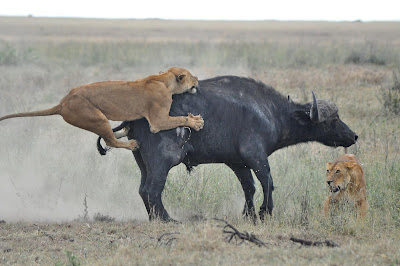Females cheetahs live alone or with their cubs, and males live in groups of 2 or 3 who are normally brother. Female cheetahs give birth to about 3 cubs, who stay with her for a year and a half to two years. When a cheetah mother loses her cubs, she makes bird-like chirping sounds so her cubs can locate her.
Feline Predators
Sunday, 11 November 2012
Lion Hunting
Lions hunt large mammals such as wildebeest, buffalo and warthogs, but they occansionaly attack larger prey such as giraffes and smaller prey such as impalas. Because impalas and other small mammals are faster than their normal prey, they need to pounce on them at the exact moment, as they have no hope at winning a chase.The lionesses do most of the hunting for the pride. When the lionesses find potential prey, they position themselves in the grass or bushes surrounding their prey. A few lionesses called flushers select a good target and chase it towards where the fastest runners of the pride, called strikers, are waiting. The strikers then leap out at the prey, attempting to knock it to the ground and kill it. Lions have long canines placed four inches apart. When they dig their canines into their prey's spine, the teeth fit perfectly into the grooves of the spine, paralysing their prey. Another method they use to kill their prey is by suffocating it. They either grasp their prey's throat until it suffocates, or hold its mouth and nostrils closed with their own mouth.
Lion Prides
Lions lives in prides of 1-3 male lions, about a dozen lionesses and their young. The males rule the pride and guard their territory. The lionesses hunt, and then bring the food back to the pride. When a male lion cub matures, he is exiled from the pride. After that, he and possibly one or two more lions tries to take over other prides by defeating the current, or resident, male leaders in the pride. If the resident males are defeated, the newcomers take over the pride and force the resident males to leave. Then, the newcomers kill all the pride's cubs.
Cheetah Hunting
Cheetahs hunt small hoofed mamals such as antelope and gazelle. Normally cheetahs will hunt during early morning and late afternoon. The tear lines running from the corner of their eye to the corner of their mouth help block out the bright sunlight. Sometimes cheetahs will climb termite mounds to search the area for food. When a cheetah spots potential prey, she stalks as close as she can towards it and then gives chase. Because the cheetah can accelerate faster than a jet plane, her prey's head start in usually lost. Cheetahs use their tails as rudders, and they can make extremely sharp turns. Thanks to their claws that can never be retracted (pulled in), they have amazing traction on the ground. When a cheetah gets close enough to her prey, she holds on to it with her razor sharp dewclaws. Then she uses her hind legs to trip her prey. When her prey falls, she holds it down and clamps her jaws around its throat, cutting of its air supply. Cheetahs will hold this throat lock for about 10 minutes before their prey suffocates and dies. The reason cheetahs can't give a killing bite to the spine, like lions, if because their aerodynamic skull leave no room for large canines and powerful jaw muscles. While suffocating their prey, cheetahs use the time to get their breath back and rest after their tiring run. Cheetahs are very clean eaters: they never return to their kill and they never eat carrion. Sadly, cheetahs are so streamlined there is no room for much muscle, so when they are challenged for their kill they often lose.
Cheetah Speed
Did you know cheetahs can run at a top speed of 70 mph? That's 112 kph! Cheetahs can run fast because they have a large heart and nostrils, and their spine contracts with so much force it gives them a stride of 25 feet! Did you know that cheetahs take 150 breahs per minute? That's twice as many as the fastest human sprinter! Also, their heart pumps over 16 litres of blood per minute, which circulates their body's entire blood supply in just less than 20 seconds! But with all that blood pumping so fast, they can only run for a minute at maximum before they overheat and need to rest. They actually have to rest anywhere from 15 to 30 minutes, just to get back to a normal heart and breathing rate! Did you know cheetahs burn 300 calories per chase? That means they need to eat more calories than they burn!
Subscribe to:
Comments (Atom)







